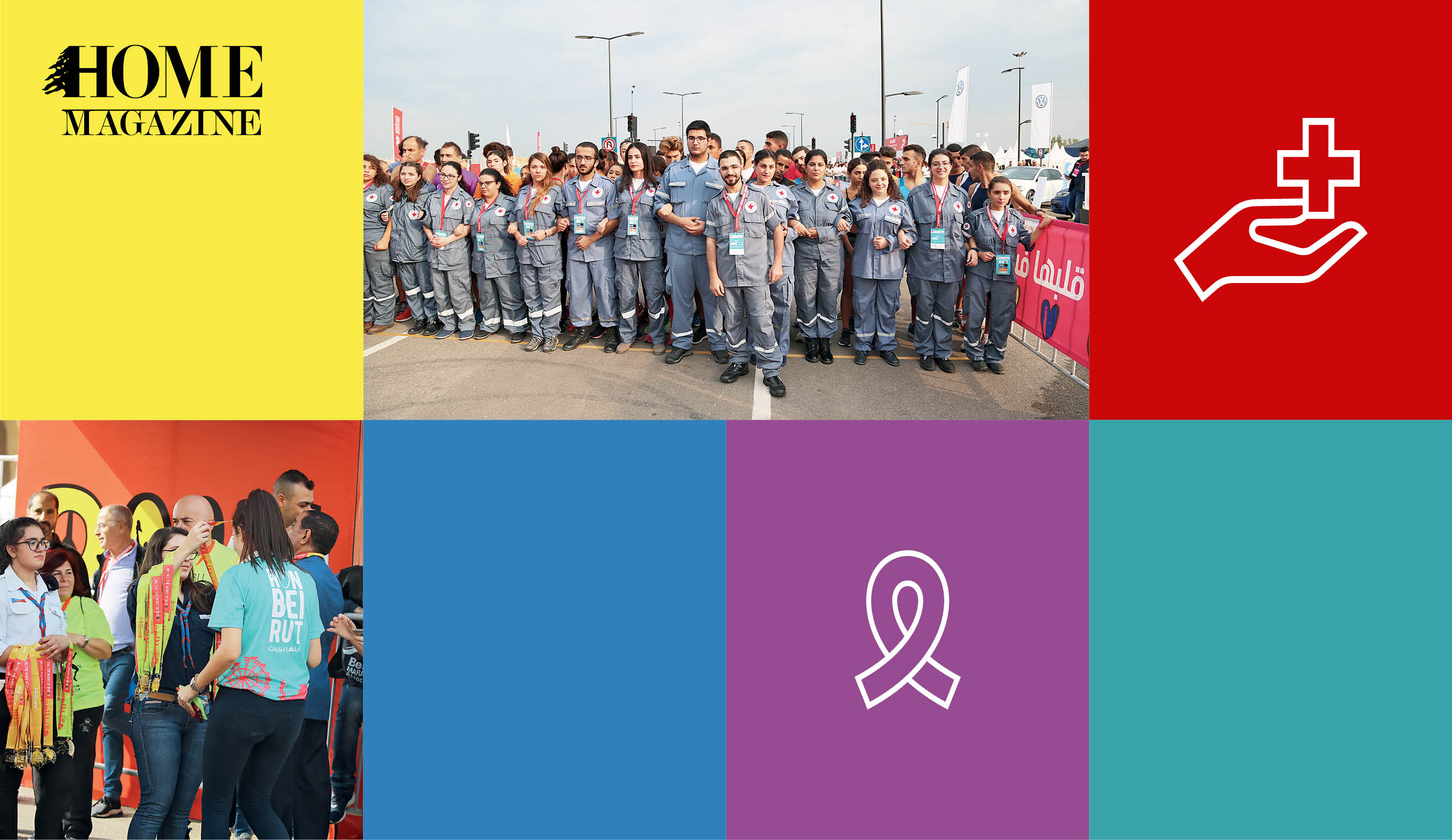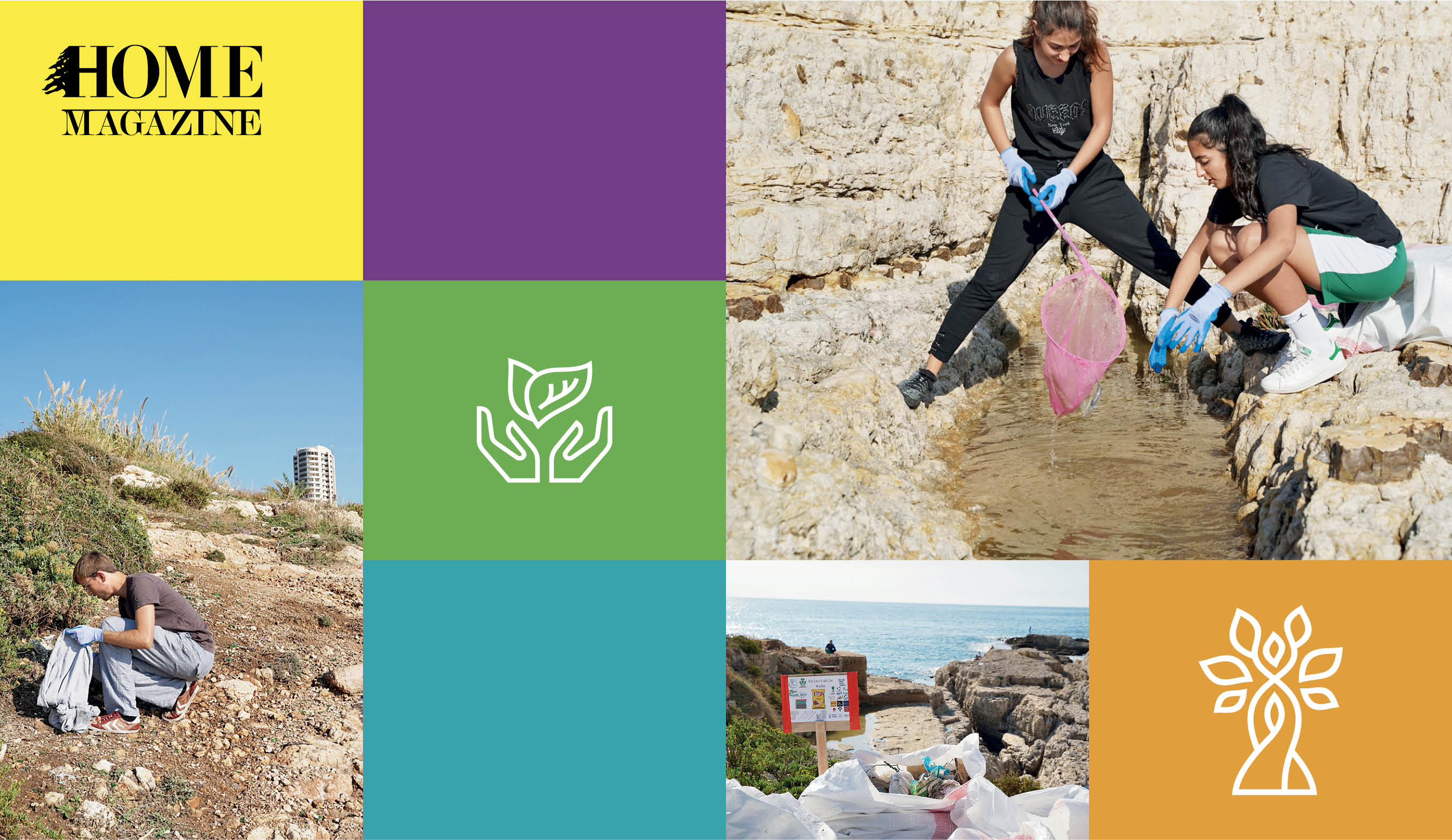Photos by: Zakaria Rakha
On October 17, 2017, 117 scuba divers from around the world spent two days collecting a ton of underwater trash including tires, plastics and medical wastes from eight coastal areas of Lebanon.
On November 5, 2017, 5,000 cedar trees were planted in the Cedars of the Lord in Bsharri by 2,000 volunteers.
On September 15, 2018 an estimated 3,500 volunteers in Lebanon participated in World Cleanup Day in more than 30 locations throughout the country, removing more than 100 tons of waste.
And on November 11, 2018 approximately 4,000 volunteers supported the 48,000 participants in the Beirut International Marathon. In addition, countless others volunteered for their individual schools and organizations to manage, drive and run alongside their runners.
While these are some of the biggest examples of episodic volunteering in Lebanon, many nonprofit organizations and service institutions engage episodic volunteers to help with their special events – Grandparents Day at Ain Wazein Hospital in Shouf, monitors for Volunteer for Lebanon who visit youth projects for National Youth Service Week, weekend carpenters who renovate or build a HOME for the HOMEless with Habitat for Humanity, and volunteers supporting conferences, local races, gala dinners and other small and large events.

What is episodic volunteering?
Volunteering, in general, has three primary criteria:
• The work is done for good – for the benefit of society.
• The person freely chooses to do it.
• And the person does it for free – without financial compensation.
Episodic volunteering (also called short-term, one-off and speed volunteering) refers to volunteering that is done for a short time (usually a few hours or days), filling the large personnel needs of a program or project without being involved in the planning or preparation. In most cases, no special skills are needed and the requirements are minimal. For tree planting and beach clean-up projects people of all ages can join in. Soup kitchens would likely impose a minimum age on their volunteers and want people who are friendly and compassionate. Volunteers for an international conference might be selected for their language skills, educational level and recommendations that they are capable of representing their country well. In most cases, the skills episodic volunteers need are easy to learn and can be taught as part of an orientation session that might include information about what to wear, what to bring and how to represent the host organization. On the other hand, underwater divers for an ocean cleanup need to be qualified divers. And medical personnel and search-and-rescue teams volunteering after an earthquake, tsunami or other natural disaster need their own special qualifications.
Why engage in episodic volunteering?
From the perspective of the volunteer, episodic volunteering is a way to contribute to a cause without having to make a long-term commitment. It is usually easy to apply, and in some cases one can just show up. It provides a meaningful way for students and employees to fill free time on a weekend, holiday, between classes or after work. It gives the volunteer the opportunity to support a specific cause or organization. It’s a great way to share an experience with family and friends, and to meet new friends. It contributes to the volunteer’s self-esteem. And in many (perhaps most) cases, it’s fun.
On the other hand, there are many benefits of long-term volunteering that are less likely to accrue to those engaged in episodic volunteering. These include developing knowledge, skills or competency, professional networking, gaining experience that would lead to a recommendation, having a deep personal connection to a cause and seeing substantial results from one’s own contributions to that cause.
While episodic volunteering is not new, some specialists in the field of volunteering have suggested that the preference for short-term, one-off volunteer opportunities has been increasing as people face greater demands upon their time.

Why engage episodic volunteers?
Many of the examples of large events at the beginning of this article need a small staff (paid or volunteer) for planning and preparation, but need a very large number of volunteers on the actual day(s) of the event. Engaging episodic volunteers can also give organizations the opportunity to introduce new people to their cause. As episodic volunteers help out at a gala dinner or conference, they can be oriented to the concerns related to diabetes, cancer, poverty, environmental degradation and other such issues. Some organizations may even organize their ongoing tasks to engage a new group of volunteers each week, in part for this reason. In addition, doing so can give the organization access to a larger pool of potential volunteers, including Scout groups and corporate volunteer teams.
“From the perspective of the volunteer, episodic volunteering is a way to contribute to a cause without having to make a long-term commitment.”
It is hoped that the experience will impact the lifestyle and behavior of the episodic volunteers, and that at least some of them will become members of the organization, ongoing volunteers, or donors, or that, at the very least, they will want to repeat the experience of serving as an episodic volunteer for the organization.
Villages and neighborhoods can organize episodic volunteer opportunities as a strategy for community building while it achieves some goal that benefits the community. While traditionally in Lebanon this was achieved through the practice of “awni” where members of a village came together to build a church, mosque, school or irrigation ditch, they now can develop a park, organize a cleanup day or plant trees. These projects can be done by hiring workers, but it is doing them together that strengthens social bonds and gives the members of the community a sense of pride in their collective accomplishment.
How to recruit and manage episodic volunteers
Engaging episodic volunteers involves the same steps of management as other volunteers (recruitment, selection, placement and orientation, management and recognition), but it is usually simplified and compressed into a shorter time frame. There are different ways that organizations recruit and manage their episodic volunteers. Here we will provide just two examples.

Episodic volunteers for the Beirut International Marathon
HOME Magazine interviewed Daniella Khalil, the volunteer manager for Beirut Marathon Association (BMA) to learn how BMA managed just under 4,000 volunteers for the 2018 Beirut International Marathon that took place on November 11, 2018. Some 2,000 of these were from the Internal Security Forces, Fire Brigade, Army and Municipality Police. While they coordinated their efforts with BMA, they were under their own management and were responsible for tasks fitting to their institutional roles. Similarly, the Red Cross volunteers served in roles appropriate to their training and their responsibilities.
The rest of the volunteers were responsible for tasks that did not need special training. They were from various schools, organizations and Scout groups. Each of these groups formed a team responsible for a specific task. They brought to the Marathon their own structure and leadership, supervised their own volunteers, kept record of who volunteered and then submitted a list of those who participated to BMA so that it could provide each volunteer with a certificate.
BMA gave leaders of these teams both general orientation and guidance related to their specific tasks, and the group leaders were then responsible for giving the necessary training and orientation to their team members. Different teams managed:
• Parking
• Traffic
• The guest area
• Lebanese and international elites
• Para-athletes
• Water stations
• The filling and distribution of end-ofrace bags
• The start and finish lines for the different races
• Bikers and cyclists monitoring the races in progress
• Entertainment stations along the race route to cheer on the runners
• The collection of water bottles and other trash from the streets.
The pre-race training sessions were important to assure the reliability of the volunteers, and those who had volunteered in previous years or other BMA races provided important guidance and support to first-timers.
Episodic volunteers for Recycle Lebanon
Recycle Lebanon, which holds cleanup projects at beaches, rivers, etc. to clean up waste throughout the year, has a different approach, as explained by its founder and director, Joslin Kehdy. It recruits its episodic volunteers entirely from social media and an online network of universities. In most cases, volunteers simply show up at the different cleanup events and are provided with the necessary equipment to do the work. Those who have volunteered at previous clean-up events help to orient newcomers. And while cleaning up the beach or river or park is an important objective of the event, it is not the only objective.
Episodic volunteering can often be a gateway volunteer opportunity or, as Joslin calls it, “a foot in the door.” With that in mind, she makes a point to talk with these one-time volunteers abou thow they might have a greater impact by becoming long-term volunteers for one of the various organizations that promote sustainability.
I attended a clean-up event held by the Evergreen Club at the American University of Beirut. The event modeled how to hold events that minimize waste that the episodic volunteers can adopt for other events. Under the motto “We don’t create waste to clean up waste,” Recycle Lebanon provided the volunteers with reusable gloves and cloth bags. Water was provided by the only company in Lebanon that distributes water in glass rather than plastic bottles, and participants drank it from a glass briq (a Lebanese water jug) or from reusable metal cups. And food for the volunteers, which was purposely as vegetarian and vegan as possible, was provided by a sponsoring restaurant in reusable, compostable and recyclable containers. Modeling such practices during the event taught the episodic volunteers about sustainability and hopefully changed their mindset about the consumption of single use plastics and other unsustainable behaviors.

Conclusions
Engaging episodic volunteers hasits limits. It is not a good way to fill volunteer opportunities that need continuity, substantial training, insurance coverage and extensive screening and supervision, or that require giving the volunteer access to confidential information. Those responsibilities need to be filled by ongoing volunteers and paid staff.
On the other hand, episodic volunteering makes many large events possible, gives organizations the opportunity to expand public exposure to their cause, and gives people with limited time the opportunity to experience many of the benefits of volunteering.

































